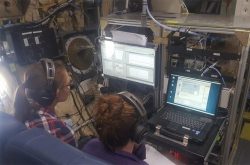
Wildfires burning in the West affect not only the areas burned, but the wider regions covered by smoke. Recent years have seen hazy skies and hazardous air quality become regular features of the late summer weather.
Many factors are causing Western wildfires to grow bigger and to generate larger, longer-lasting smoke plumes that can stretch across the continent. An analysis led by the University of Washington looks at the most detailed observations to date from the interiors of West Coast wildfire smoke plumes.
The multi-institutional team tracked and flew through wildfire plumes from the source to collect data on how the chemical composition of smoke changed over time. A resulting paper, published Nov. 2 in the Proceedings of the National Academy of the Sciences, shows that smoke forecasts may incorrectly predict the amount of particles in staler smoke.
The new results could significantly change the estimate for particles in staler smoke, which could be the difference between “moderate” and “unhealthy” air quality in regions downwind of the fire.
“Wildfires are getting larger and more frequent, and smoke is becoming a more important contributor to overall air pollution,” said lead author Joel Thornton, a UW professor of atmospheric sciences. “We really targeted the smoke plumes close to the source to try better understand what’s emitted and then how it can transform as it goes downwind.”
Knowing how newly generated wildfire smoke transitions to stale, dissipated smoke could lead to better forecasts for air quality. Communities can use those forecasts to prepare by moving outdoor activities inside or rescheduling in cases where the air will be unsafe to be outdoors, as well as limiting other polluting activities such as wood-burning fires.
Read more at UW News »
